Moto Guzzi from Mandello del Lario (Como Lake)

Moto Guzzi is an Italian motorcycle manufacturer. It is one of seven brands owned by Piaggio.
Established in 1921 near Milan, Northern Italy, the company is noted for its central historic role in Italys motorcycling manufacture, its prominence worldwide in motorcycle racing, and a series of industry innovations – including the first motorcycle center stand, wind tunnel and eight-cylinder engine. Similar to other storied motorcycle manufacturers that have survived for decades, Moto Guzzi has experienced a series of business cycles and a series of ownership arrangements—some complex, some brief, some that have endured. Moto Guzzi was conceived by two aircraft pilots and their mechanic serving in the Corpo Aeronautico Militare (the Italian Air Corp, CAM) during World War I: Carlo Guzzi, Giovanni Ravelli and Giorgio Parodi. Assigned to the same Miraglia Squadron based outside Venice,[4] the three became close, despite coming from different socio-economic backgrounds.
The trio envisioned creating a motorcycle company after the war. Guzzi would engineer the motor bikes, Parodi (the son of wealthy Genovese ship-owners) would finance 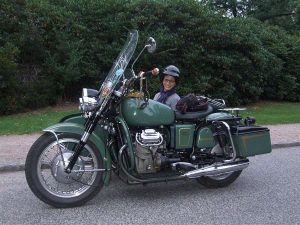 the venture, and Ravelli (already a famous pilot and motorcycle racer) would promote the bikes with his racing prowess. Guzzi and Parodi (along with Parodis brother) formed Moto Guzzi in 1921. Ravelli, ironically, had died just days after the wars end in an aircraft crash and is commemorated by the eagles wings that form the Moto Guzzi logo. Moto Guzzi, Museum of Brescello. The GT Norge, Moto Guzzi Museum, Mandello del Lario, driven 4,000 miles (6,400 km) to the Arctic Circle in 1928. Carlo Guzzi and Giorgio Parodi, along with Giorgios brother Angelo, created a privately held silent partnership „Società Anonima Moto Guzzi“ on 15 March 1921, for the purpose of (according to the original articles of incorporation) „the manufacture and the sale of motor cycles and any other activity in relation to or connected to metallurgical and mechanical industry“. The formation of the company hinged on an initial loan of two thousand Lira from the Parodis father, Emanuele Vittorio, which he gave on 3 January 1919, offering the balance of the loan upon his review of the projects progress: Dear Giorgio, you can let both your partners know that I will offer you for your first 1,500 or 2,000 Lire. Although with the condition that the sum, under no circumstances, shall be increased. Likewise, I reserve the right to supervise your progress before giving my agreement to this project. The company was legally based in Genoa, Italy, with its headquarters in Mandello.
the venture, and Ravelli (already a famous pilot and motorcycle racer) would promote the bikes with his racing prowess. Guzzi and Parodi (along with Parodis brother) formed Moto Guzzi in 1921. Ravelli, ironically, had died just days after the wars end in an aircraft crash and is commemorated by the eagles wings that form the Moto Guzzi logo. Moto Guzzi, Museum of Brescello. The GT Norge, Moto Guzzi Museum, Mandello del Lario, driven 4,000 miles (6,400 km) to the Arctic Circle in 1928. Carlo Guzzi and Giorgio Parodi, along with Giorgios brother Angelo, created a privately held silent partnership „Società Anonima Moto Guzzi“ on 15 March 1921, for the purpose of (according to the original articles of incorporation) „the manufacture and the sale of motor cycles and any other activity in relation to or connected to metallurgical and mechanical industry“. The formation of the company hinged on an initial loan of two thousand Lira from the Parodis father, Emanuele Vittorio, which he gave on 3 January 1919, offering the balance of the loan upon his review of the projects progress: Dear Giorgio, you can let both your partners know that I will offer you for your first 1,500 or 2,000 Lire. Although with the condition that the sum, under no circumstances, shall be increased. Likewise, I reserve the right to supervise your progress before giving my agreement to this project. The company was legally based in Genoa, Italy, with its headquarters in Mandello.
The very earliest motorcycles bore the name G.P. (Guzzi-Parodi), though the marque quickly changed to Moto Guzzi. As the only actual shareholders, the Parodis wanted to shield their shipping fortunes by avoiding confusion of name G.P. with Giorgio Parodis initials. Carlo Guzzi initially received royalties for each motorcycle produced, holding no ownership in the company that bore his name. In 1946 Moto Guzzi formally incorporated as Moto Guzzi S.p.A. with Giorgio Parodi as chairman. Carlo Guzzis first engine design was a horizontal single that dominated the first 45 years of the companys history in various configurations. Through 1934, each engine bore the signature of the mechanic who built it. As originally envisioned, the company used racing to promote the brand. In the 1935 Isle of Man TT, Moto Guzzi factory rider Stanley Woods performed an impressive double victory with wins in the Lightweight TT as well as the Senior TT. Until the mid 1940s, the traditional horizontal four-stroke single-cylinder 500 cc engines outfitted with one overhead and one side valve (also known as: IOE, inlet over exhaust or F-head) were the highest performance engines Moto Guzzi sold to the general public. By contrast, the company supplied the official racing team and private racers with higher performance racing machines with varying overhead cam, multi-valve configurations and cylinder designs. Moto Guzzi Airone Sport 1949. In the 1950s, Moto Guzzi, along with the Italian factories of Gilera and Mondial, led the world of Grand Prix motorcycle racing.
With durable and lightweight 250 cc and 350 cc bikes designed by Giulio Carcano, the firm dominated the middleweight classes. The factory won five consecutive 350 cc world championships between 1953 and 1957. In realizing that low weight alone might not continue to win races for the company, Carcano designed the V8 500 cc GP race bike—whose engine was to become one of the most complex engines of its time. Despite the bikes having led many races and frequently posted the fastest lap time, it often failed to complete races because of mechanical problems. Ultimately, the V8 was not developed further as Moto Guzzi withdrew (together with the main competitors Gilera and Mondial) from racing after the 1957 season citing escalating costs and diminishing motorcycle sales. 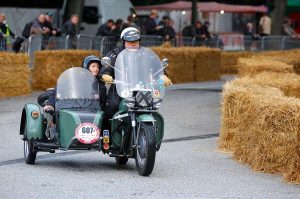 By the time of its pull out from Grand Prix racing, Moto Guzzi had won 3,329 official races, 8 World Championships, 6 Constructors Championships and 11 Isle of Man TT victories. The period after World War II was as difficult in Mandello del Lario as it was elsewhere in post-war Europe. The solution was production of inexpensive, lighter cycles. The 1946 „Motoleggera“, a 65 cc lightweight motorcycle became very popular in post-war Italy. A four-stroke 175 cc scooter known as the „Galletto“ also sold well. Though modest cycles for the company, the lighter cycles continue to feature Guzzis innovation and commitment to quality. The step-through Galletto initially featured a manual, foot-shifted three-speed (160 cc) configuration then later a four-speed (175 cc) set-up by the end of 1952. The displacement was increased to 192 cc in 1954 and electric start was added in 1961. Moto Guzzis Large Wheel Scooter Moto Guzzi was limited in its endeavors to penetrate the important scooter market as motorcycle popularity waned after WWII. Italian scooter competitors would not tolerate an incursion from Moto Guzzi. By innovating the first large-wheeled scooter, Guzzi competed less directly with manufacturers of small-wheeled scooters such as Piaggio (Vespa) and Lambretta. To illustrate the delicate balance within the Italian post-war motorcycle and scooter markets, when Guzzi developed their own prototype for a small-wheeled scooter, Lambretta retaliated with a prototype for a small V-twin motorcycle threatening to directly compete on Moto Guzzis turf. The two companies compromised: Guzzi never produced their small-wheeled scooter and Lambretta never manufactured the motorcycle. Notably, the drive train that Lambretta made in their 1953 motorcycle prototype remarkably resembles the V-twin + drive shaft arrangement that Guzzi developed more than ten years later, ultimately to become iconic of the company.
By the time of its pull out from Grand Prix racing, Moto Guzzi had won 3,329 official races, 8 World Championships, 6 Constructors Championships and 11 Isle of Man TT victories. The period after World War II was as difficult in Mandello del Lario as it was elsewhere in post-war Europe. The solution was production of inexpensive, lighter cycles. The 1946 „Motoleggera“, a 65 cc lightweight motorcycle became very popular in post-war Italy. A four-stroke 175 cc scooter known as the „Galletto“ also sold well. Though modest cycles for the company, the lighter cycles continue to feature Guzzis innovation and commitment to quality. The step-through Galletto initially featured a manual, foot-shifted three-speed (160 cc) configuration then later a four-speed (175 cc) set-up by the end of 1952. The displacement was increased to 192 cc in 1954 and electric start was added in 1961. Moto Guzzis Large Wheel Scooter Moto Guzzi was limited in its endeavors to penetrate the important scooter market as motorcycle popularity waned after WWII. Italian scooter competitors would not tolerate an incursion from Moto Guzzi. By innovating the first large-wheeled scooter, Guzzi competed less directly with manufacturers of small-wheeled scooters such as Piaggio (Vespa) and Lambretta. To illustrate the delicate balance within the Italian post-war motorcycle and scooter markets, when Guzzi developed their own prototype for a small-wheeled scooter, Lambretta retaliated with a prototype for a small V-twin motorcycle threatening to directly compete on Moto Guzzis turf. The two companies compromised: Guzzi never produced their small-wheeled scooter and Lambretta never manufactured the motorcycle. Notably, the drive train that Lambretta made in their 1953 motorcycle prototype remarkably resembles the V-twin + drive shaft arrangement that Guzzi developed more than ten years later, ultimately to become iconic of the company.
By 1964, the company was in full financial crisis. Emanuele Parodi and his son Giorgio had died, Carlo Guzzi had retired to private life, and direction passed to Enrico Parodi, Giorgios brother. Carlo Guzzi died on 3 November 1964, in Mandello, after a brief hospital stay in Davos. In February 1967, SEIMM (Società Esercizio Industrie Moto Meccaniche), a state controlled receiver, took ownership of Moto Guzzi. The SEIMM oversight saw Moto Guzzi adapting to a cultural shift away from motorcycles to automobiles. The company focused on popular lightweight mopeds including the Dingo and Trotter – and the 125 cc Stornello motorcycle. Also during the SEIMM years Guzzi developed the 90° V twin engine, designed by Giulio Cesare Carcano, which would become iconic of Moto Guzzi. Moto 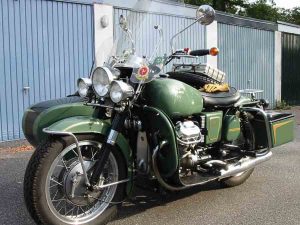 Guzzi, V7 750 Speciale from 1969 Though Moto Guzzi has employed engines of myriad configurations, none has come to symbolize the company more than the air-cooled 90° V-twin with a longitudinal crankshaft orientation and the engines transverse cylinder heads projecting prominently on either side of the bike. The original V-twin was designed in the early 1960s by engineer Giulio Cesare Carcano, designer of the DOHC V8 Grand Prix racer. The air-cooled, longitudinal crankshaft, transverse cylinder, pushrod V-twin began life with 700 cc displacement and 45 hp (34 kW) – designed to win a competition sponsored by the Italian government for a new police bike. The sturdy shaft-drive, air-cooled V-twin won, giving Moto Guzzi renewed competitiveness. This 1967 Moto Guzzi V7 with the original Carcano engine has been continuously developed into the 1,200 cc, 80 hp (60 kW) versions offered today (2006). Lino Tonti redesigned the motor for the 1971 Moto Guzzi V7 Sport. This engine is the basis of the currently used 750 cc, 1,100 cc and 1,200 cc Guzzi engines. Notably, the longitudinal crankshaft and orientation of the engine creates a slight gyroscope effect, with a slightly asymmetrical behavior in turns. After experiencing financial difficulties in the late 1960s, De Tomaso Industries Inc. (D.T.I. Group or DTI), manufacturer of the De Tomaso sports and luxury cars, owned by Argentinian industrialist Alejandro de Tomaso, purchased SEIMM (and thereby Moto Guzzi) along with Benelli and Maserati in 1973. Under Tomasos stewardship, Moto Guzzi returned to profitability, though other reports suggest a period of limited investment in Moto Guzzi followed attributed to DTI using Moto Guzzi financially prioritizing their automotive ventures. In 1976 Guzzi released the 850 Le Mans, a cafe racer that was a stylistic masterpiece and still today considered one of the most iconic and sought after of all Guzzis. A marketing success that would compete with other Italian superbikes, it spawned four later models from Mark II to its culmination in the 1990s, the Mark V. The initial model is known widely but incorrectly as the Mark I. Technically, it is simply the 850 Le Mans. It was named in homage to the 24-Hour endurance race and circuit in France.
Guzzi, V7 750 Speciale from 1969 Though Moto Guzzi has employed engines of myriad configurations, none has come to symbolize the company more than the air-cooled 90° V-twin with a longitudinal crankshaft orientation and the engines transverse cylinder heads projecting prominently on either side of the bike. The original V-twin was designed in the early 1960s by engineer Giulio Cesare Carcano, designer of the DOHC V8 Grand Prix racer. The air-cooled, longitudinal crankshaft, transverse cylinder, pushrod V-twin began life with 700 cc displacement and 45 hp (34 kW) – designed to win a competition sponsored by the Italian government for a new police bike. The sturdy shaft-drive, air-cooled V-twin won, giving Moto Guzzi renewed competitiveness. This 1967 Moto Guzzi V7 with the original Carcano engine has been continuously developed into the 1,200 cc, 80 hp (60 kW) versions offered today (2006). Lino Tonti redesigned the motor for the 1971 Moto Guzzi V7 Sport. This engine is the basis of the currently used 750 cc, 1,100 cc and 1,200 cc Guzzi engines. Notably, the longitudinal crankshaft and orientation of the engine creates a slight gyroscope effect, with a slightly asymmetrical behavior in turns. After experiencing financial difficulties in the late 1960s, De Tomaso Industries Inc. (D.T.I. Group or DTI), manufacturer of the De Tomaso sports and luxury cars, owned by Argentinian industrialist Alejandro de Tomaso, purchased SEIMM (and thereby Moto Guzzi) along with Benelli and Maserati in 1973. Under Tomasos stewardship, Moto Guzzi returned to profitability, though other reports suggest a period of limited investment in Moto Guzzi followed attributed to DTI using Moto Guzzi financially prioritizing their automotive ventures. In 1976 Guzzi released the 850 Le Mans, a cafe racer that was a stylistic masterpiece and still today considered one of the most iconic and sought after of all Guzzis. A marketing success that would compete with other Italian superbikes, it spawned four later models from Mark II to its culmination in the 1990s, the Mark V. The initial model is known widely but incorrectly as the Mark I. Technically, it is simply the 850 Le Mans. It was named in homage to the 24-Hour endurance race and circuit in France.
The Mark I had two production runs with slight modifications. The first run, known as Series 1, used the roundish CEV stop/taillight used on many Italian bikes of the decade. Less than 2,000 of the round taillight bikes were made and they are the most desirable Guzzi of the era. The second production run, known as the Series 2 and totaling around 4,000 bikes, used a De Tomaso-designed rectangular taillight/reflector and modified rear guard. This was also used on the Mark II and SP models. The taillight and guard was the biggest change between Series 1 and 2 but other modifications included later inclusion of a tripmeter, black fork lowers, a more generous dual seat that replaced the split-proned original seat, exhaust pipe heel guards and inferior fuel taps. The extra cost compared to the „cooking“ T3 model paid for performance items such as high compression domed pistons, larger inlet and exhaust valves and Dell Orto 36 mm pumper carbs with filterless grey plastic velocity stacks. Most Mk I bikes were brilliant red although a very small number were painted in metallic ice blue. An exceedingly small number of Series 2 bikes were white. In 1979 a small block version of the air-cooled V-twin designed by engineer Lino Tonti was introduced as the V35. Radical when introduced, the design featured horizontally split crankcases and Heron heads. The former was a common feature of contemporary Japanese motorcycle 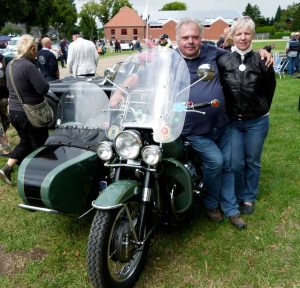 design, whilst the latter was widely used in car engines. Both features allow more efficient mass production and also the design of the engine and associated components cut the weight from 548 lb (249 kg) of the contemporary 850 T3 to the 385 lb (175 kg) of the V35. The power of the original V35 at 35 bhp (26 kW) was competitive with engines of comparable displacement of the period – later larger versions (V50, V65, V75) were rapidly outclassed by competing water-cooled engines. Notably, the Breva and Nevada today feature a descendent of Tontis V35 engine: the 750 cc V-twin, rated at 48 bhp (36 kW). With its ease of maintenance, durability and even, flat torque curve, the engine design remains suitable to everyday, real-world situations. As Guzzi continued to develop the V-twin, power was increased in the mid 1980s when Guzzi created 4-valve versions of the „small block“ series. Of these, the 650 and the 750 were rated at 60 bhp (45 kW) and 65 bhp (48 kW) respectively. The production of the 4-valve „small block“ engines ended in the later 1980s. Moto Guzzis have used an hydraulic integrated brake system, where the right front disc works off the handlebar lever, while the left front and the rear disc work off the foot brake.
design, whilst the latter was widely used in car engines. Both features allow more efficient mass production and also the design of the engine and associated components cut the weight from 548 lb (249 kg) of the contemporary 850 T3 to the 385 lb (175 kg) of the V35. The power of the original V35 at 35 bhp (26 kW) was competitive with engines of comparable displacement of the period – later larger versions (V50, V65, V75) were rapidly outclassed by competing water-cooled engines. Notably, the Breva and Nevada today feature a descendent of Tontis V35 engine: the 750 cc V-twin, rated at 48 bhp (36 kW). With its ease of maintenance, durability and even, flat torque curve, the engine design remains suitable to everyday, real-world situations. As Guzzi continued to develop the V-twin, power was increased in the mid 1980s when Guzzi created 4-valve versions of the „small block“ series. Of these, the 650 and the 750 were rated at 60 bhp (45 kW) and 65 bhp (48 kW) respectively. The production of the 4-valve „small block“ engines ended in the later 1980s. Moto Guzzis have used an hydraulic integrated brake system, where the right front disc works off the handlebar lever, while the left front and the rear disc work off the foot brake.
The cartridge front fork used in Guzzis motorcycles of the later 1970s and 1980s is a Guzzi invention. Instead of containing the damping oil in the fork it is in a cartridge. Oil in the fork is purely for lubrication. Still under the De Tomaso umbrella, in 1988, Benelli 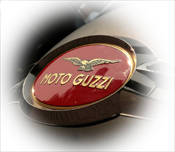 and SEIMM merged to create Guzzi Benelli Moto (G.B.M. S.p.A. ). During this period, Moto Guzzi existed as an entity within the De Tomaso owned G.B.M., but in 1996 celebrated its 75th birthday and the return of its name to Moto Guzzi S.p.A. In 1996, De Tomaso became Trident Rowan Group, also known as TRG. Under the helm of Ivano Beggio, Aprilia S.p.A acquired Moto Guzzi S.p. A on 14 April 2000 for $65 million. According to the original press release, the intention had been that Moto Guzzi would remain headquartered in Mandello del Lario and would share Aprilia s technological, R&D capabilities and financial resources as well. The arrangement would remain short-lived, as Aprilia itself stumbled financially. At the same time Aprilia attempted to diversify in other areas of manufacturing, new Italian laws required helmets for motorcyclists and raising insurance rates for teenage motorcyclists, severely affected the companys profitability. Nonetheless, Aprilia had committed large sums to renovating the Mandello Moto Guzzi factory – renovations that were ultimately completed. Notably, Ducati Motor Holding again made an offer for Moto Guzzi during Aprilias financial difficulties, as it had before, when Aprilia had purchased Moto Guzzi in 2000. Other potential buyers included Kymco and the BRP subsidiary Rotax, Kymco reportedly making the highest offer.
and SEIMM merged to create Guzzi Benelli Moto (G.B.M. S.p.A. ). During this period, Moto Guzzi existed as an entity within the De Tomaso owned G.B.M., but in 1996 celebrated its 75th birthday and the return of its name to Moto Guzzi S.p.A. In 1996, De Tomaso became Trident Rowan Group, also known as TRG. Under the helm of Ivano Beggio, Aprilia S.p.A acquired Moto Guzzi S.p. A on 14 April 2000 for $65 million. According to the original press release, the intention had been that Moto Guzzi would remain headquartered in Mandello del Lario and would share Aprilia s technological, R&D capabilities and financial resources as well. The arrangement would remain short-lived, as Aprilia itself stumbled financially. At the same time Aprilia attempted to diversify in other areas of manufacturing, new Italian laws required helmets for motorcyclists and raising insurance rates for teenage motorcyclists, severely affected the companys profitability. Nonetheless, Aprilia had committed large sums to renovating the Mandello Moto Guzzi factory – renovations that were ultimately completed. Notably, Ducati Motor Holding again made an offer for Moto Guzzi during Aprilias financial difficulties, as it had before, when Aprilia had purchased Moto Guzzi in 2000. Other potential buyers included Kymco and the BRP subsidiary Rotax, Kymco reportedly making the highest offer.
The Moto Guzzi assembly line closed for a short period in March 2004, due to the financial difficulties. On 30 December 2004, Piaggio & Co. S.p.A acquired Aprilia and thereby Moto Guzzi, forming Europes largest motorycle manufacturer. Moto Guzzi S.p. A officially becomes a Unico Azionista of Piaggio, part of Immsi S.p.A. Investments have allowed introduction of a series of competitive new models in rapid succession. In November 2007, Moto Guzzi unveiled the retro-themed 2008 V7 Classic at the Motorcycle and Bicycle Manufacturers show in Milan, Italy. It was available in Europe in mid-2008, and Moto Guzzi announced plans in late-2008 to make it available to U.S. buyers.
Author: Volker Westphal
